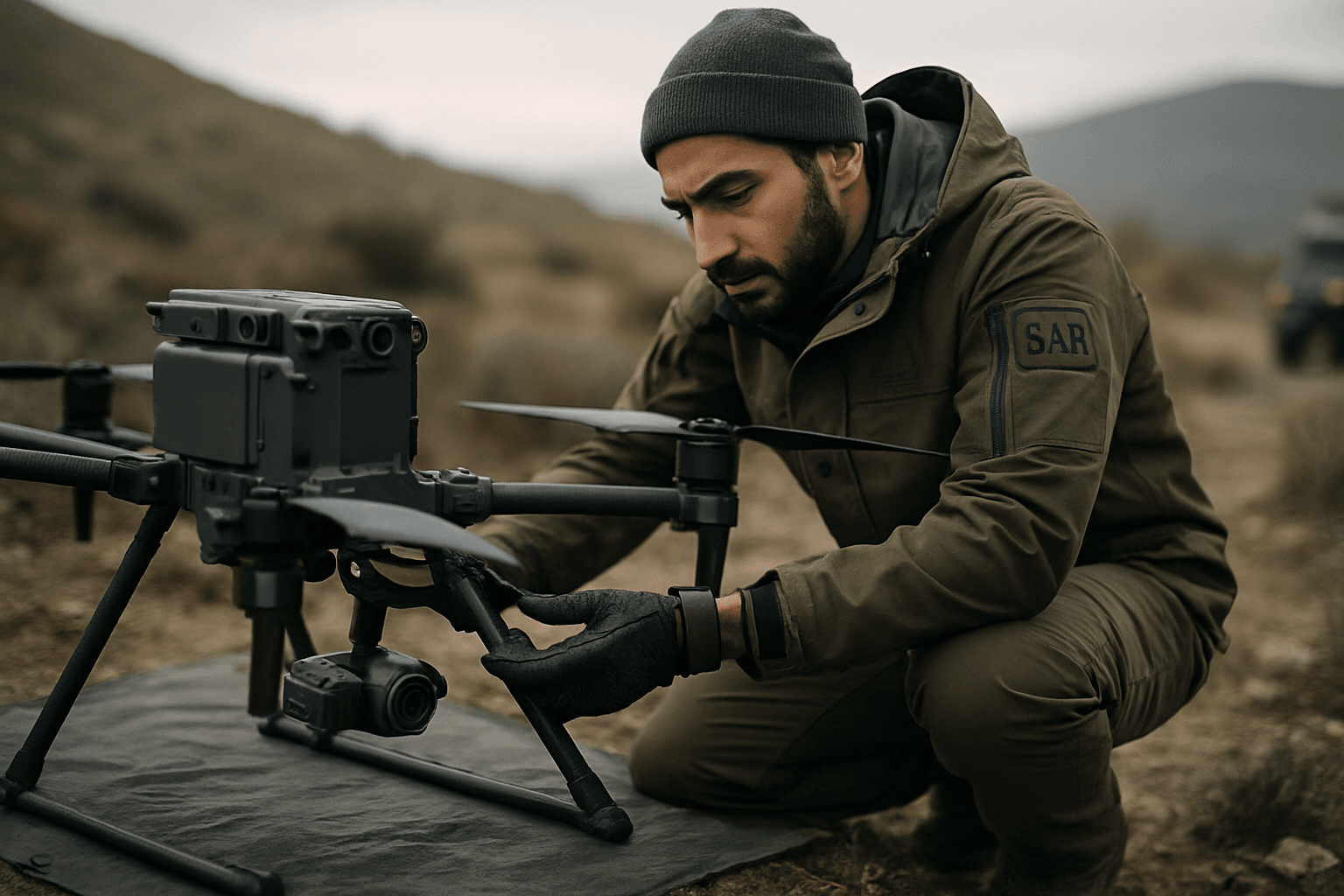In the high-stakes world of Search and Rescue (SAR) operations, Unmanned Aerial Systems (UAS), or drones, have become indispensable tools, offering a bird’s-eye view, accessing challenging terrain, and providing critical real-time data to ground teams. However, the success and safety of these life-saving missions hinge on meticulous preparation, with drone pre-flight inspections being a non-negotiable step. Unlike recreational flying, SAR missions often occur in unpredictable and extreme conditions, demanding an even more rigorous approach to pre-flight checks to ensure mission readiness, equipment integrity, and the safety of all involved.
This guide outlines best practices for conducting comprehensive drone pre-flight inspections, specifically tailored to the diverse and demanding environments encountered in SAR operations. By integrating these procedures, SAR teams can maximize their drones’ effectiveness, minimize risks, and ultimately, improve the chances of a successful rescue.
The Criticality of Pre-Flight Inspections in SAR
Every drone flight carries inherent risks, but in SAR, the consequences of failure are amplified. A drone malfunction can not only lead to lost or damaged equipment but, more critically, can delay locating a missing person or assessing a disaster zone. Thorough pre-flight checks are the first line of defense against these risks, ensuring the UAS is airworthy and capable of performing its mission in challenging circumstances.
Core Elements of a Comprehensive Drone Pre-Flight Checklist
A robust pre-flight checklist for SAR drones extends beyond basic checks, incorporating considerations for varied environmental factors and mission-specific requirements.
1. Hardware and Airframe Integrity
The physical condition of the drone is paramount. A meticulous visual and tactile inspection is essential to identify any damage or wear that could compromise flight stability or performance.
- Propellers and Motors: Carefully inspect each propeller blade for nicks, cracks, warping, or any signs of damage. Even minor imperfections can cause vibrations, affect stability, and lead to mission failure. Spin each motor by hand to check for resistance, grinding, or unusual sounds, which could indicate debris or bearing issues.
- Frame and Arms: Examine the drone’s body and arms for stress fractures, cracks, loose screws, or any signs of impact damage. Hard landings or impacts during transport can cause damage that is not immediately obvious.
- Landing Gear: Verify that the landing gear is stable, free from damage, and that any locking mechanisms are secure.
- Antennas: Confirm that all antennas are properly positioned and securely attached, as loose antennas can compromise communication links.
- Payload and Gimbals: Ensure all SAR-specific payloads, such as thermal (EO/IR) cameras, high-resolution RGB cameras, communication relays, or dropping mechanisms, are securely mounted and free from physical damage. Check the gimbal for free movement and stability, as well as the camera lens for cleanliness and any obstructions.
2. Battery and Power Management
Battery health is the “heart” of a drone, and a sudden power failure can be catastrophic, especially during extended SAR missions.
- Physical Inspection: Examine each battery for signs of damage, such as swelling (puffing), dents, punctures, or frayed connector wires. A swollen battery is a significant fire risk and must be decommissioned immediately.
- Charge Level Verification: Confirm all batteries for the drone and controller are at 100% charge. For intelligent batteries, use the flight app to verify all cells are balanced and reporting correct voltage.
- Temperature Check: Batteries should be at a moderate, ambient temperature before flight. In cold weather, preheating batteries to above 25°C is crucial to reduce internal resistance and prevent rapid voltage drops or premature failure.
- Spare Batteries: Always carry spare, fully charged batteries, particularly for extended operations or remote locations, as SAR missions often require prolonged flight times. Implementing a battery rotation schedule can ensure “ready to fly” power sources are always available.
- Automated Battery Management: For persistent missions or swarm deployments, advanced battery management systems (BMS) that monitor health, optimize power usage, and enable automated battery swaps can significantly extend operational time and improve mission efficacy.
3. Software and System Checks
Beyond physical components, the drone’s digital brain and communication systems require thorough verification.
- Firmware Updates: Ensure the drone, controller, and intelligent batteries have the latest firmware updates to ensure optimal performance and access to the newest safety features.
- Sensor Calibration: Calibrate all critical sensors, including the compass, GPS, and Inertial Measurement Unit (IMU), to ensure accuracy and stable flight.
- GPS and Navigation System: Verify a strong GPS lock with a sufficient number of satellites before takeoff. A robust GPS signal is vital for stable flight, automated functions, and reliable Return-to-Home (RTH) capabilities.
- Communication and Control Link: Perform a thorough link test to confirm stable and robust communication between the drone and the controller. Check signal strength indicators for both remote control (RC) and video transmission. Modern flight apps often include interference scans or spectrum analyzers. For SAR, reliable communication is vital for real-time data transfer and control, especially in challenging environments or Beyond Visual Line of Sight (BVLOS) operations.
- Fail-Safe Settings: Confirm that fail-safe settings, such as RTH altitude and low-battery thresholds, are correctly configured for the mission.
- Memory Cards: Ensure memory cards for cameras or sensors are formatted and have sufficient storage space for the mission’s data.
4. Environmental and Airspace Assessment
SAR operations rarely happen in ideal conditions. A detailed assessment of the operational environment is crucial.
- Weather Conditions: Conduct a comprehensive weather assessment, going beyond a quick glance at an app. Monitor current and forecasted conditions, including wind speed and direction, temperature, precipitation (rain, snow), and visibility. Understand the drone’s maximum operating wind speed and temperature limits. Strong winds can significantly affect flight paths and battery life, while cold temperatures can degrade battery performance.
- Local Topography and Hazards: Assess the terrain for potential hazards such as power lines, trees, buildings, water bodies, or other obstacles. In rugged or mountainous SAR environments, identify potential take-off/landing areas and secondary landing zones.
- Airspace Analysis: Use dedicated drone flight apps (e.g., B4UFLY, AirMap) to analyze the airspace for any temporary flight restrictions (TFRs) or controlled airspace requirements. Obtain necessary authorizations, such as LAANC, if operating in controlled airspace.
- Electromagnetic Interference (EMI): Be aware of potential sources of electromagnetic interference that could disrupt communication or GPS signals, especially near power lines, radio towers, or urban areas.
Varied SAR Conditions: Specific Considerations
SAR operations often push drones to their operational limits. Specific adjustments to pre-flight inspections are needed for varied conditions:
Cold Weather / Snowy Conditions
- Battery Management: As noted, preheat batteries to optimal operating temperature (above 20-25°C). Monitor battery status continuously during flight, as cold can cause rapid voltage drops. Aggressive control inputs can also cause sudden voltage drops in cold.
- Propellers: Inspect for ice accumulation before and during flight.
- Sensors: Ensure obstacle avoidance sensors and cameras are clear of snow or condensation.
- GPS Signal: Snowy environments can sometimes affect GPS reception; ensure a strong signal.
- Landing Gear: Use a landing pad in snowy or icy terrain to prevent snow ingestion or slipping. Drones with an IP rating of at least IP43 are recommended for operations where weather may turn quickly.
High Wind Conditions
- Wind Speed Limits: Strictly adhere to the drone’s maximum operating wind speed specified in the manual, typically 15-20 mph for most consumer drones. Use a handheld anemometer for on-site verification of wind speed and gusts.
- Battery Consumption: Strong winds significantly increase battery consumption; plan shorter flight times and account for higher power drain.
- Flight Path: Be mindful that strong winds can distort flight paths and reduce data collection quality.
- RTH Function: Be aware that Return-to-Home (RTH) may not save the drone in exceptionally strong winds.
Rugged or Challenging Terrain
- Take-off/Landing Zones: Identify clear and stable take-off and landing areas, considering uneven ground, loose debris, or dense vegetation. A landing pad can be invaluable.
- Obstacle Avoidance: Ensure obstacle avoidance sensors are fully functional and calibrated. Newer drones with AI-powered obstacle avoidance are ideal for complex environments.
- Payload Protection: In dusty or debris-filled environments, ensure payload cameras and sensors are protected and cleaned before and after flight.
- Visual Observer (VO): In challenging terrain, a dedicated visual observer is even more critical to identify potential hazards like powerlines or changes in elevation that the pilot might miss.
Conclusion
The meticulous execution of pre-flight inspections is not merely a regulatory compliance but a fundamental safety and operational imperative for drone pilots in Search and Rescue. By adopting a comprehensive checklist that addresses hardware integrity, robust battery management, software readiness, and dynamic environmental considerations, SAR teams can significantly enhance the reliability and effectiveness of their UAS deployments. As drone technology continues to evolve, integrating these best practices will ensure that UAS remains a powerful, life-saving asset in the most demanding conditions.





